When we moved into our new house a few weeks ago, one of the very first things we wanted to change was the lighting situation in the bedrooms. All the bedrooms had no overhead lighting. Instead, they all had an outlet on a switch so you could plug a lamp in.
We really wanted overhead lighting so that we could do a fan and light combo to keep the rooms cooler in the summer.
After doing a lot of research and consulting with an electrician, we learned we could install the fan box and run the wire to the light switch ourselves. (It was actually pretty easy and only took us a day to do this in all four bedrooms).
After we did that, we would only need an electrician at the end to wire the light switch and take the outlet off the light switch. Thus, saving us a lot of money on the project by dramatically reducing the amount of labor we were paying for.
In this guide, you will learn how to install a ceiling light (and fan) and get the wires from the light to your light switch. After that, call your electrician to wire the light switch, enjoy the money savings and the room’s new ambiance.
Overview of the Process:
The whole process can be broken down into 5 parts:
- Install a braced fan box (You)
- Run a wire from the fan box to the switch (You)
- Install the ceiling fan/light fixture (You or an Electrician)
- Wire the switch (Electrician)
- Take the outlet off the switch (Electrician)
Now, you could hire an electrician to do all these steps but that will be very pricey. However, doing the steps I recommend (and are covered in this post) will dramatically reduce your costs by slashing the amount of labor you’re paying for.
The steps that I recommend an electrician do such as wiring the electrical switch will not be covered in this post. Those tasks (the switch especially) should be left to a licensed electrician as improper wiring could result in injury, death, or fire. If you decide to take those on, there are a lot of YouTube videos that do cover those subjects.
Tools and equipment
In order to do this project, you will need the following supplies:
- Tape Measure: You will use this to measure the center of your room to know where to put the ceiling fan/light.
- Sheetrock saw: Once you find the center of the room, you will use a sheetrock saw to cut a hole. You will also need this later on in the project to cut a hole above the light switch on the wall.
- Braced Fan Box(es): The fan box is what you put in the ceiling to attach your fan/light fixture to the ceiling. You will need one for each room.
- Power Drill: You will need this to drill holes (normal drill bit and long drill bit) so you can feed a wire the ceiling and to screw the fan box in the ceiling.
- Ladder: This will help you measure the ceiling to find the center but also to access the attic.
- Wire Coat hanger: Or something similar. You will use this to find the center of the room in the attic.
- N95 mask: You will use this when you go into the attic and it will protect you from insulation, especially if you have blown fiberglass insulation.
- Protective clothing: Wear gloves, long pants, long socks, long-sleeve shirt when in the attic so that you can protect your skin from the insulation, which can make you itch like crazy.
- 14/3 Romex wiring: This is the cord that you will feed through the fan box and then all the way to the light switch. I bought two 50 foot spools to do four bedrooms.
- Ceiling Fan/light Fixture: Pick out one for each room depending on your style. Here is the fan we used.
- Dimmable Fan/Light Switch: Assuming you’re doing a ceiling fan, you’ll want a switch that’ll fit in a single outlet that can dim both the fan and the light. Here is the one we used.
- Drywall Compound and Putty knife: You will use this to patch the hole above the light switch.
- Sheetrock Patch, Drywall Joint Tape: To fix the area above the light switch.
- Sanding Sponge: Medium Grit (~120). After the putty dries, you will sand it smooth before painting.
- Wall paint color: The last step to repairing the wall is to re-paint it.
Overall, this project costed us roughly $800 to do four bedrooms since we already had a power drill, tape measure, ladder, and sheetrock saw. Our ceiling fan/light fixtures made up the bulk of the cost since they were $150 each. Outside of the ceiling fan/light fixtures we bought, doing this tutorial in 4 bedrooms would cost $200 total.
My husband is very skilled at doing electrical so we saved even more by not hiring an electrician (although I’d advise against that for most people).
The project can be easily done in a day. We did all four bedrooms in a day.
Next, I will break up the tutorial in parts with each step described in great detail.
Part 1: Install the Fan Box
The first step in this tutorial is to install a fan box in the ceiling at the center of each room. For this part, you will need the following supplies:
- Tape measure
- Sheetrock saw
- Braced fan box
- Power drill
- Extra long drill bit (1/2” thick)
- Ladder
- Wire coat hanger
- N95 Mask
- Protective Clothing
Step 1: Measure the exact center of the room
Take your tape measure and measure the room’s width and length. Once you have these measurements, divide each in half.
Making these measurements along the ceiling is difficult, so start out by measuring on the ground your half distance. Then you’ll go from there along the ceiling to measure your second distance. Make a tiny mark on the ceiling (in pencil) where your center is. Then measure your first distance along the ceiling to confirm you have the right spot.
Step 2: Drill a hole and poke a wire through
At the center of the room, drill a hole in the ceiling.
Now, use a wire coat hanger (or something similar) and feed it through. You will use this to locate the same spot when you go into the attic.
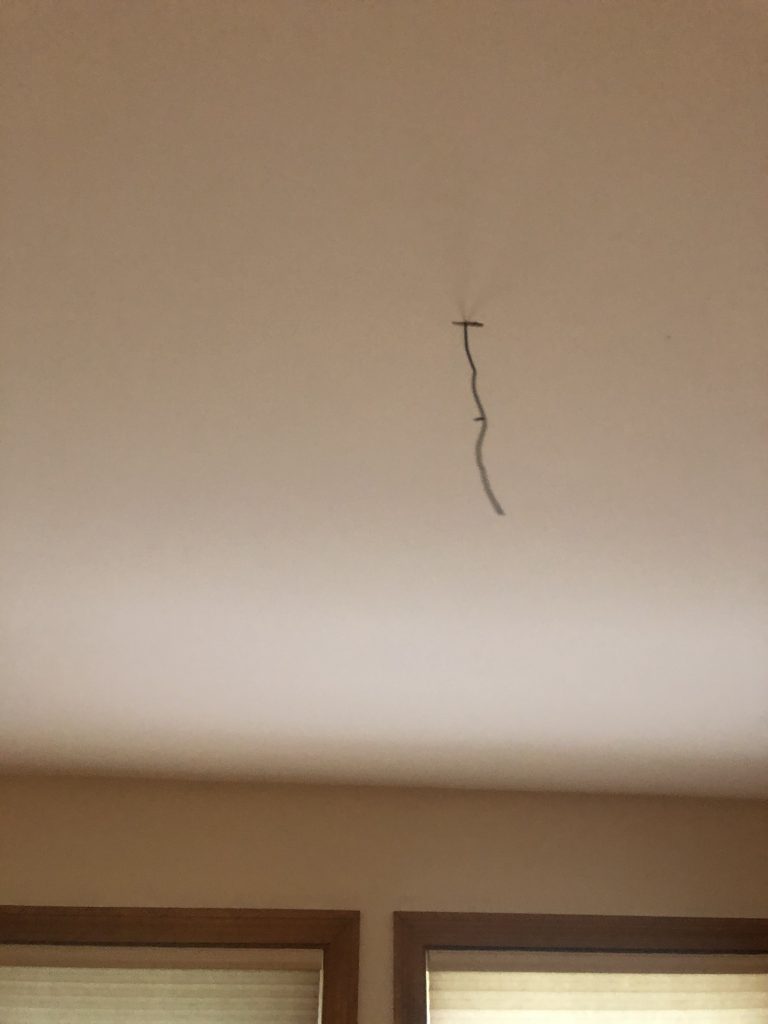
Step 3: Get on protective gear for the attic
Next, you need to find the spot via the coat hanger in the attic. Start by gearing up with putting on protective clothing (gloves, long socks, pants, long-sleeved shirt) and lastly an N95 mask. This will protect you from fiberglass insulation.
Once you have all your gear on, grab a ladder and use it to go into your attic access.
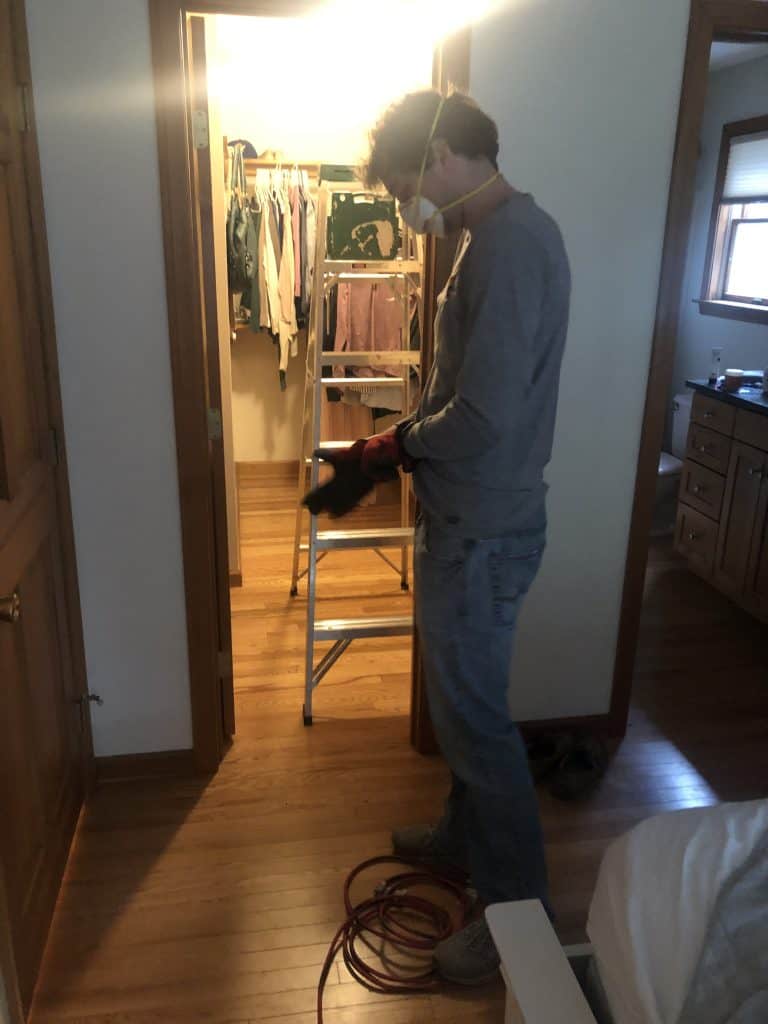
Step 4: Locate the wire in the attic and clear insulation off the spot
Once you are in the attic, you should be able to see the wire sticking out. It might help if you can have someone wiggle the wire from the room.
Once you locate the wire, you want to move the insulation off of that spot. You can just use your gloved hand and push it aside.
You will be cutting a small hole in the ceiling for the fan box and you don’t want the insulation falling out and into the room. Once you are done with the project, you can move the insulation back over the spot.
You can see all of the fiberglass insulation floating in the air in the GIF below, which shows why it really is so important you wear that N95 mask.

Step 5: Outline and cut a hole for the fan box
After you clear the insulation away, come out of the attic and find your braced fan box. Place the center of the box at the center of the room (where you drilled the hole).
Trace the outline of the box (which is actually a circle) with a pencil.
Now, take a sheetrock saw and cut the hole in the ceiling using the circle you traced as your guide. As you can see in the picture, it is a good idea to wear your N95 mask incase insulation falls out.
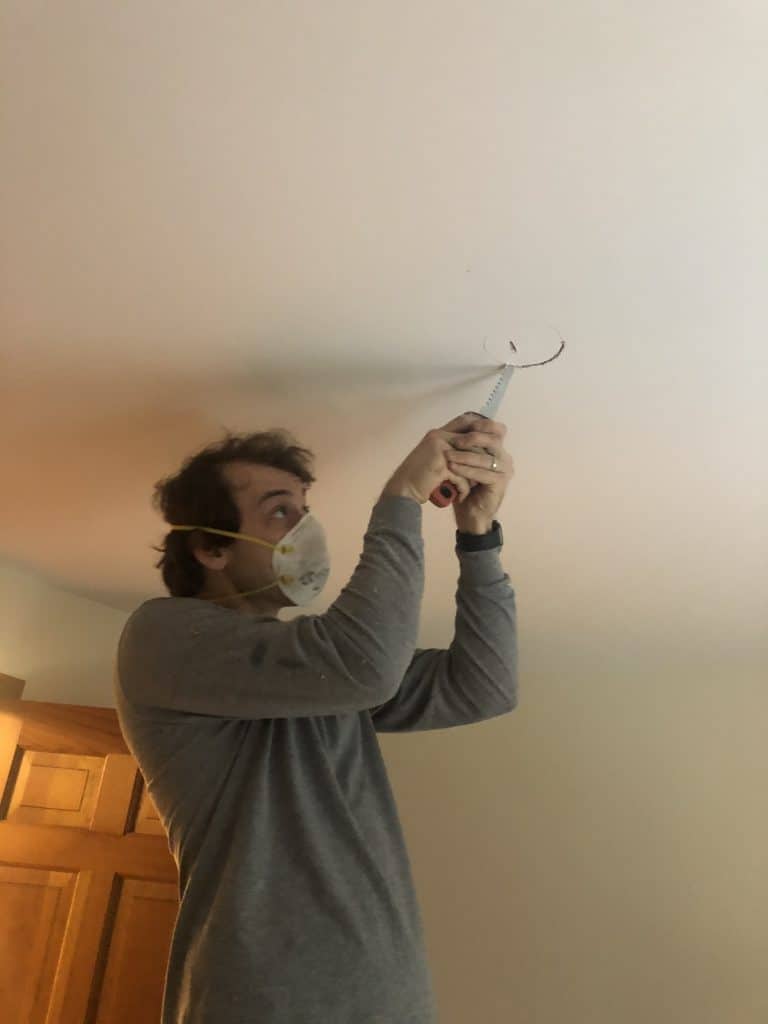
Here is a picture of what your ceiling should look like after you complete this step.
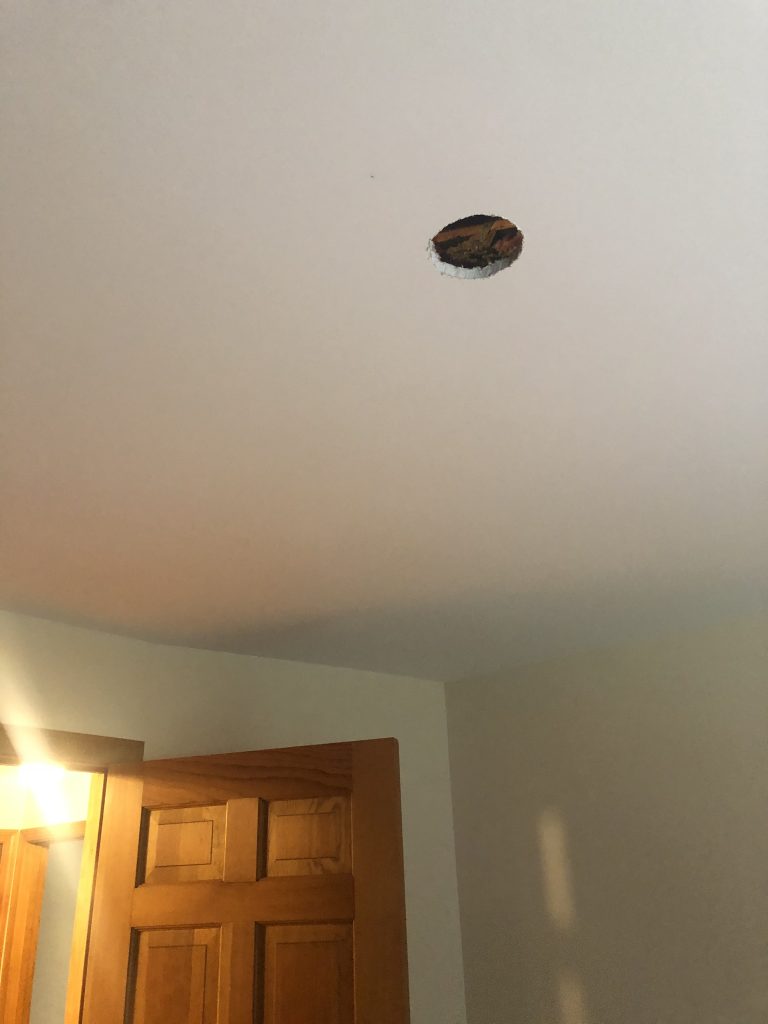
Step 6: Prep and install the fan box
In this step, you will go back up into the attic and screw the fan box in place with your power drill.
However, before you do that, take a moment to prep the fan box.
After we installed the first one, we realized that it was easier if you flipped the bar around so that the holes for screwing are exposed from the top rather than the bottom.
The picture below shows the default setup, since they are usually installed from the bottom when building a new house before sheetrock is done.
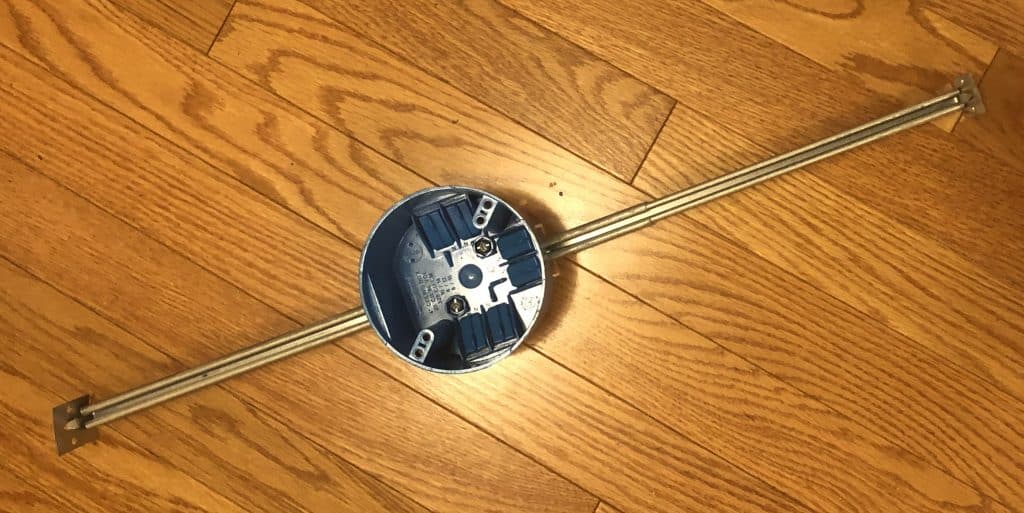
So, what you want to do is just
- loosen the two screws in the box
- rotate the bar 180 degrees
- re-tighten the screws.
This will save a lot of frustration when you’re up in the hot insulated attic.
Now you are ready to install the fan box. Bring the fan box and a power drill into the attic and install the braced fan box in the cut hole.
To do this, adjust the bar length until it will reach the two side beams. Before you screw it in place, make sure you have a person holding the box flush against the ceiling. You could hold a board or a book against the bottom to keep it flush.
Once it’s installed it should look like the picture below. You are done here, you can put the insulation back in place.
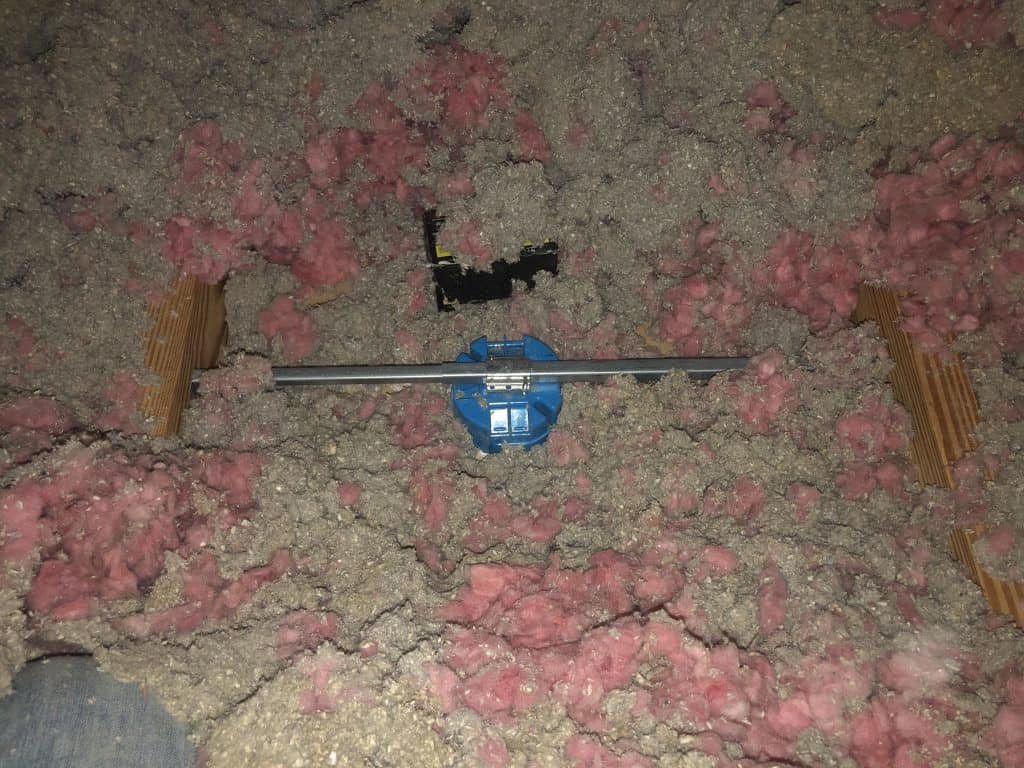
Part 2: Run the wire from fan box to electric switch
Now that you have your braced fan box in place, it is time to take the 14/3 Romex wire and run it from the fan box to the light switch. The supplies you need for this step are:
- 14/3 Romex Wiring
- Sheetrock saw
- Power drill
- Extra long drill bit (1/2” thick)
- Ladder
- Wire coat hanger
- N95 Mask
- Protective Clothing
IMPORTANT STEP: TURN OFF THE BREAKER! While you won’t be wiring the light switch, you will open it, so be sure you turn off the breaker for the room.
Step 1: Drill a small hole directly above your light switch and feed a coat hanger through
The first thing you want to do is use your drill and make a small hole in the ceiling directly above the light switch.
Once you make the hole, you will be doing a similar process as before. Using a wire, feed it through the hole as a marker to find the same spot when in the attic.
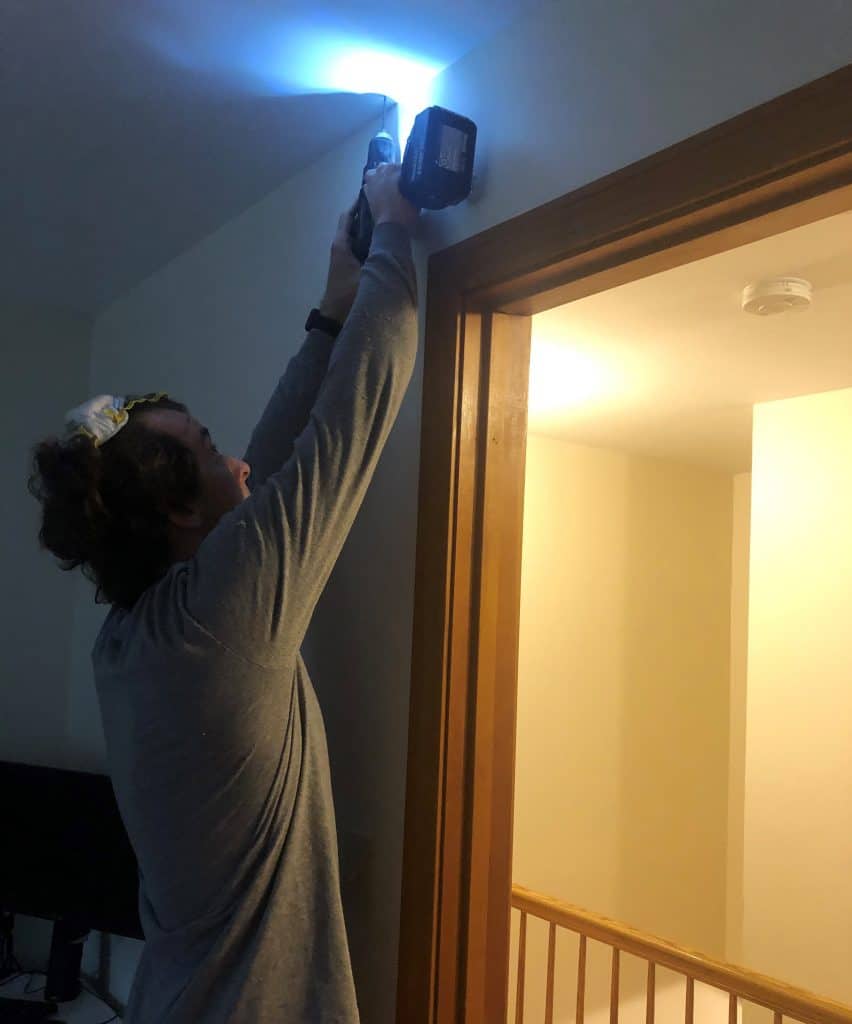
Step 2: Locate the wire in the attic and drill down through the stud
Once you find the wire in the attic, clean away the insulation. Once you do this, you’ll be able to locate the stud that you’ll have to drill down through to feed your wire through the wall to the switch.
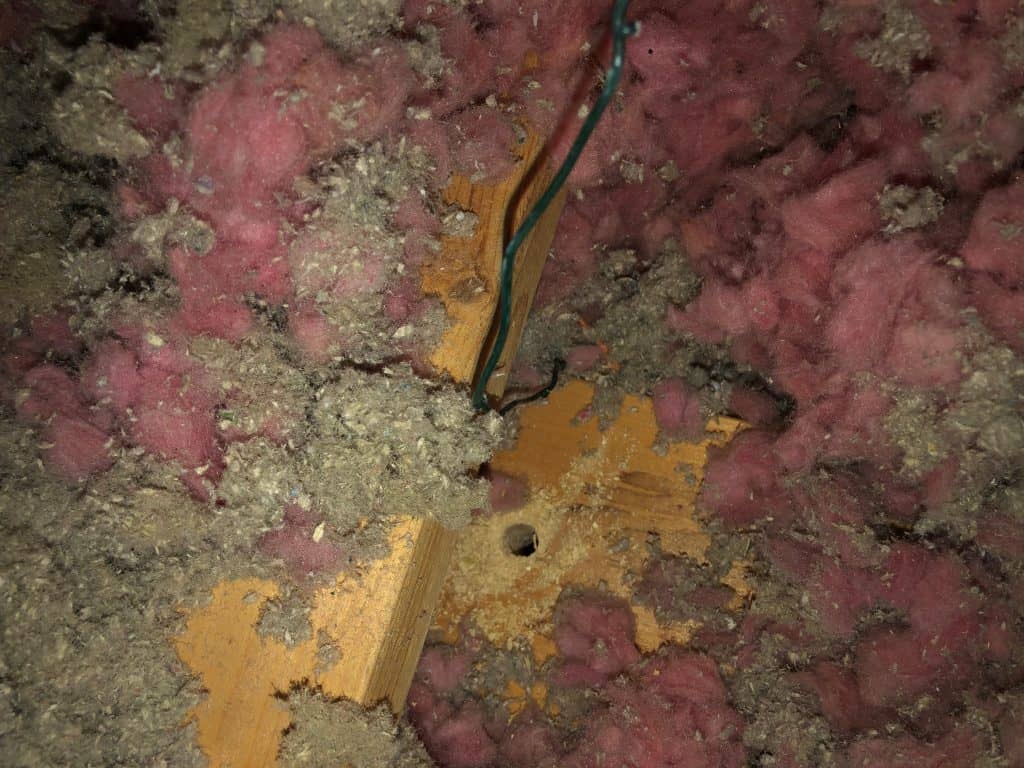
Step 3: Open the light switch
First check there is no power going to your light switch. You do this by trying to turn the light on. If the lamp (or whatever is connected to your switched outlet) does not turn on, then you are good to go.
Once you check the power is off, open the light switch by taking the plate off and pull the switch forward. The purpose of doing this is to get the switch out of the way in the following steps. You can see what I mean in the picture in the next step.
Step 4: Cut a small square in the wall above your outlet
When you feed the wire from the fan box through the attic to your light switch, you will need to be able to grab it and feed it through the electrical box.
By cutting a small hole directly above the light switch box, you will be able to reach into the wall and grab the wire in later steps. Don’t worry, at the end of this post, I will tell you how to patch the wall.
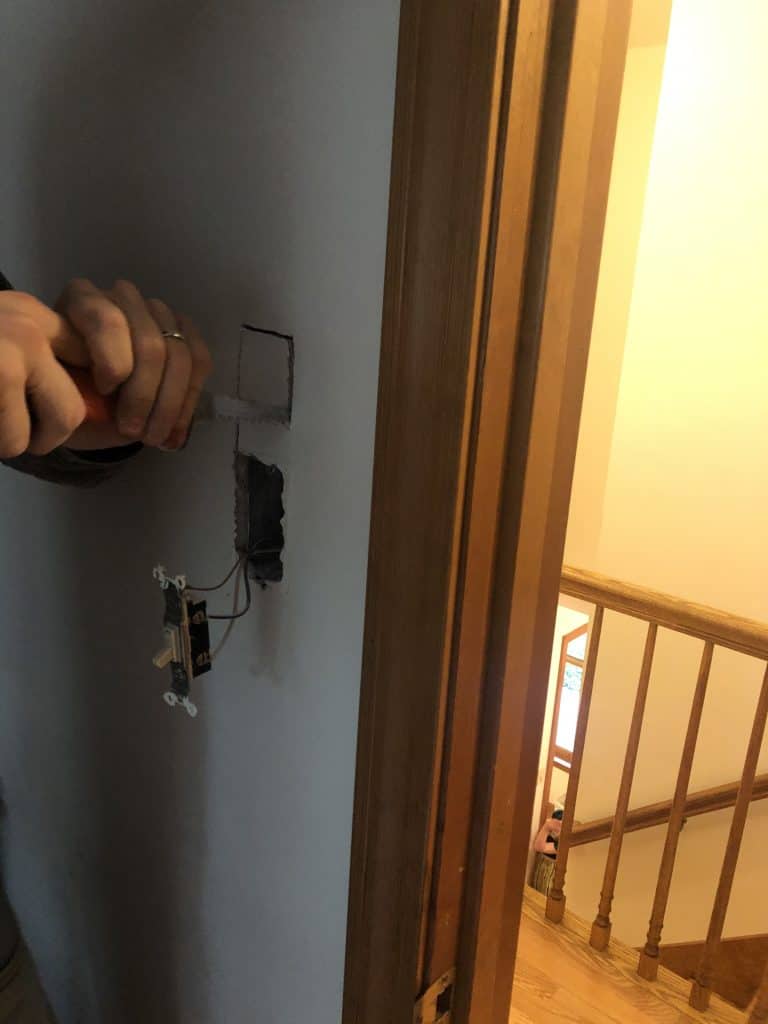
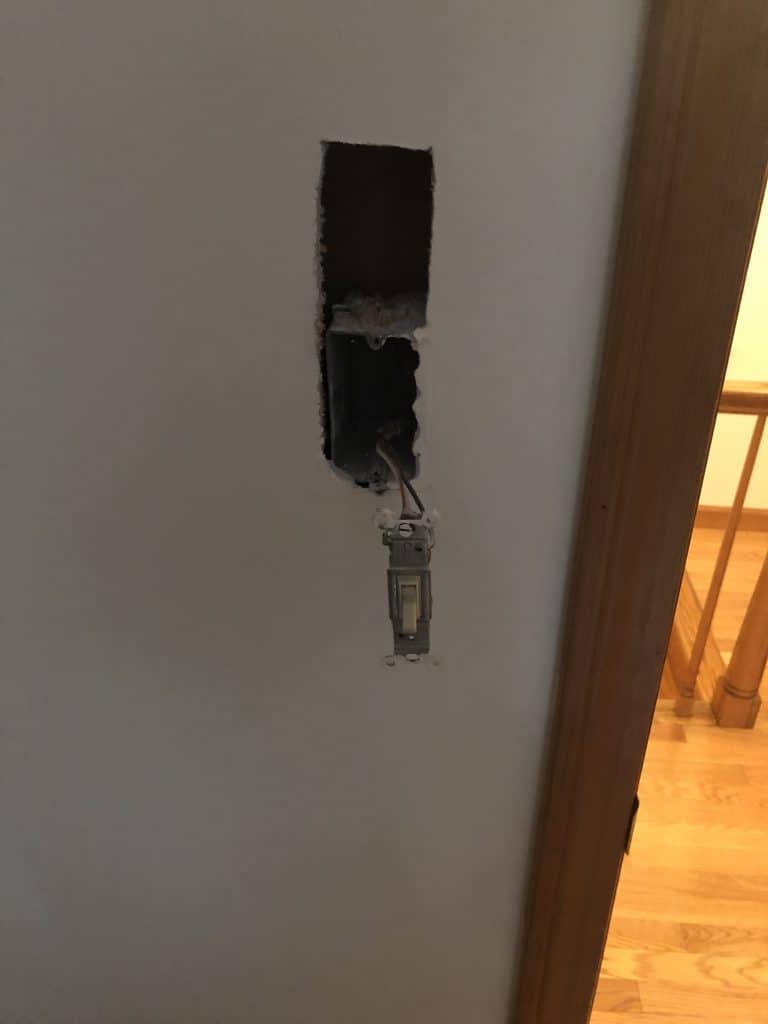
Step 5: Feed your wire through the fan box into the attic
Now you’ll want to feed the 14/3 wire through the fan box.
It’s best if you have one person in the room feeding wire, and another person in the attic helping to pull it. There are little openings in the fan box and in the switch box that can be opened using a flathead screwdriver or needle-nosed pliers.
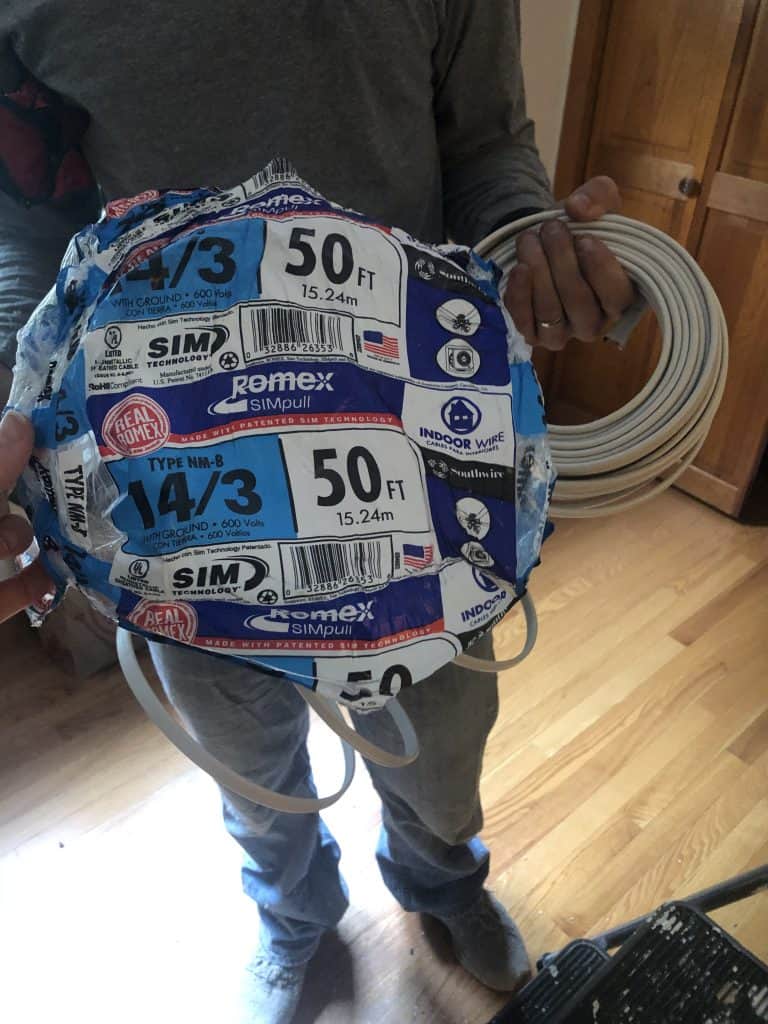

Step 6: From the attic, grab the wire and then feed it down the wall
Now, grab that wire in the attic and feed it through the hole and down the wall. This step is much easier with two people. While one person feeds the wire down the wall, the other person can look for it in the hole above the light switch.

Step 7: Open up a new tab on your switch box and feed the wire through
Once, you find the wire in the wall, you want to pull it through a tab on your switch box.
If you have no open tabs or your switch box is full, just leave the wire outside the box and leave it for your electrician.
Once you finish this step, you’re ready for your electrician!
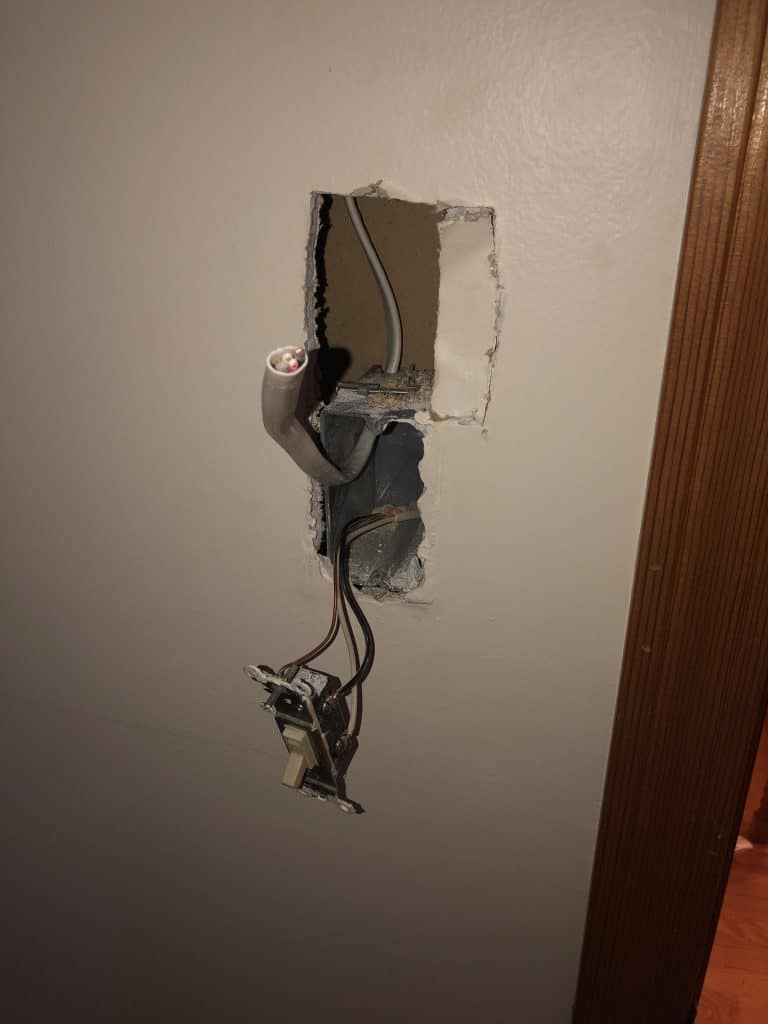
Part 3: Buy and install your light fixture
Now that you have installed the fan box and fed the wire through, you can go ahead and install the ceiling fan/light. For this part, you want to follow the instructions that come with the light fixture. You can also leave this part for the electrician but usually the directions are detailed and easy to follow.
The fan/light fixture we bought for our rooms was the Arleigh 44in. LED White Ceiling Fan I liked them because the reviews said
- Easy to install
- Very quiet fan
I also liked them because they were white, and I have read from home decor sites that it is best for them to blend into the ceiling instead of sticking out (and being an eye sore).
Here is a picture of our beautiful new ceiling fan and light!

Part 4: Repair the wall
You do not want to repair the wall until you’ve had the electrician come and wire the light switch. Once that is finished, you are good to go on putting the wall back together. For that you will need:
- Sheetrock Putty
- Putty knife
- Mesh Drywall Joint Tape
- Scrap wood or 1”x4” pine board
- Sheetrock screws
- Sheetrock patch that matches your existing wall thickness
Step 1: Cut back the sheetrock to expose the stud.
This will give you a space to nail the sheetrock patch.
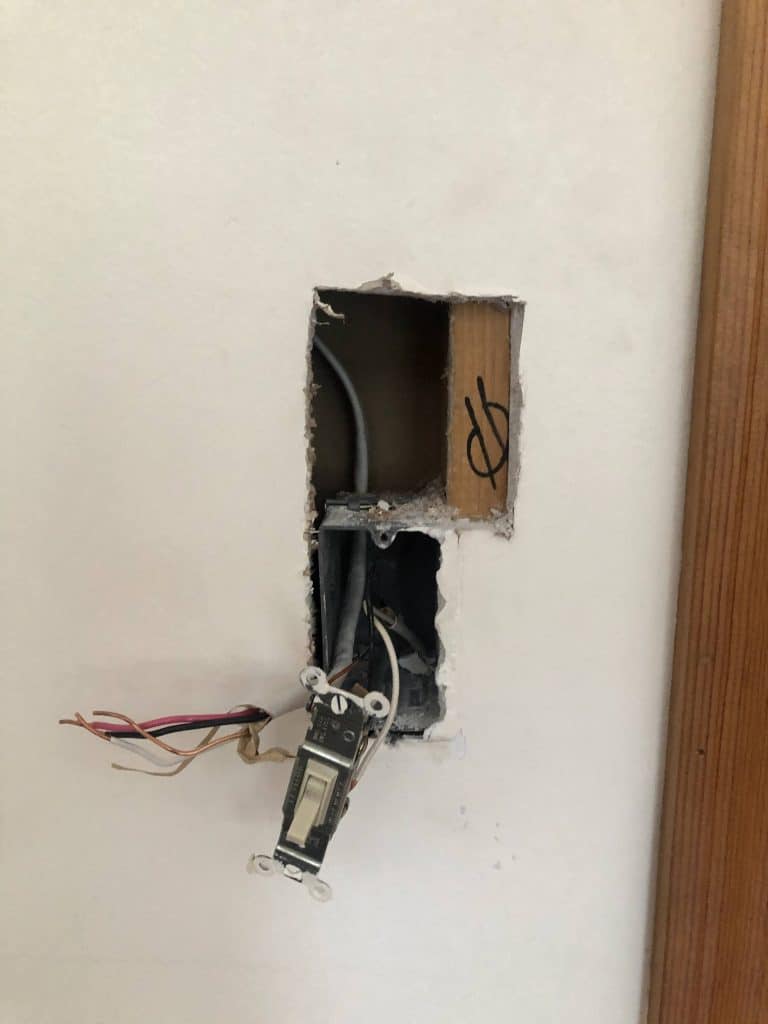
Step 2: Cut a piece of scrap board to install
You’ll want a board that’s at least 3-4 inches wide so you have enough space to attach the existing sheetrock and enough space to attach the sheetrock patch. Make this piece a few inches longer than the opening so you have room to screw in the patch. You could use a scrap piece of plywood, or maybe even a scrap 2×4. The best option would be a 1×4, but use whatever you have lying around that will fit.
Step 3: Slip the board behind the wall and attach the existing sheetrock with sheetrock screws

Step 4: Measure the new opening and cut your sheetrock patch
It’s okay to not have the measurement and fit be exact, the joint compound will cover the cracks. It’s better to have your patch be too small than too large.
Step 5: Screw in the patch to the stud and the board you added
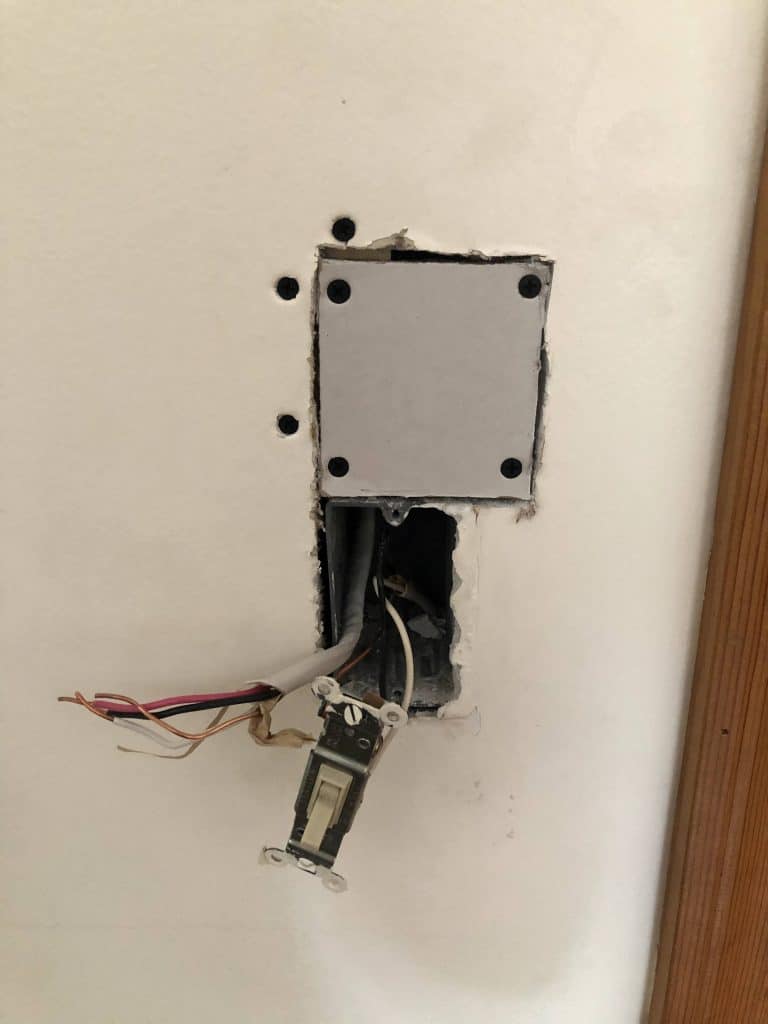
Step 7: Tape the seams and apply joint compound.
Using mesh drywall joint tape, you want to cover all of the gaps or seams (not pictured). This will prevent the drywall from cracking down the road.
It will probably take a few layers to get it looking right. Apply a layer, let it dry completely, then apply another layer. Keep doing this until you’ve completed covered the drywall tape and matched the plane of the existing wall. As you can see in my picture, your first layer won’t be pretty, but don’t worry, it’ll look good in the end.
While you have the joint compound out, you can also use it to cover the hole in your ceiling you drilled directly above the light switch.
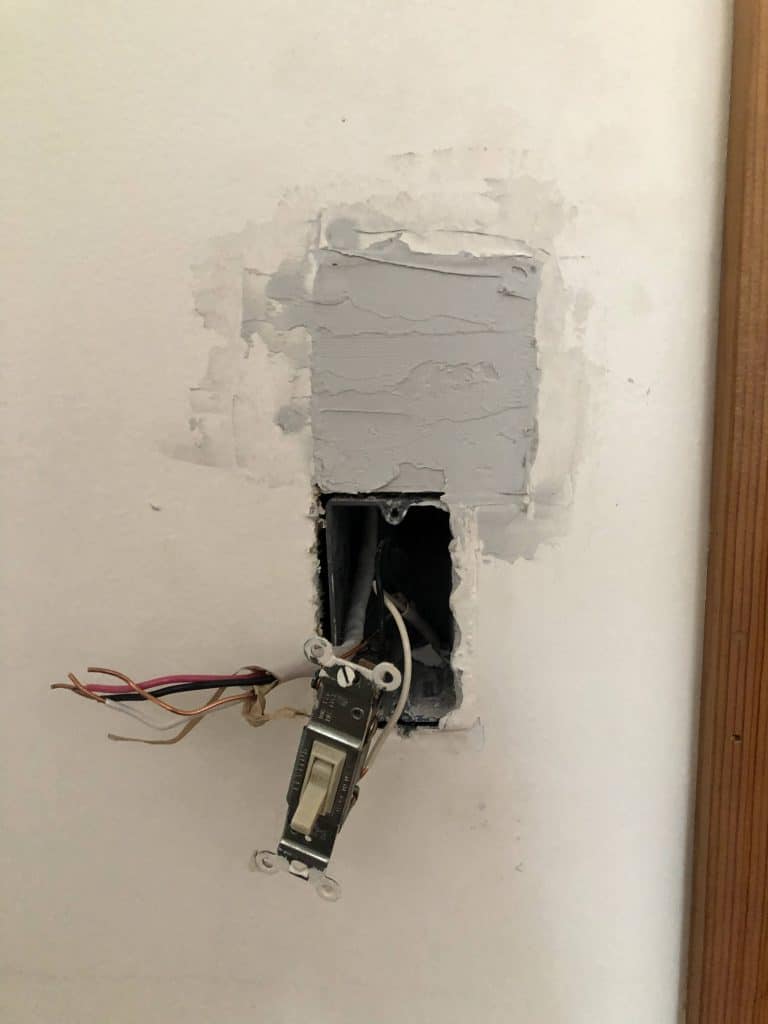

Step 8: Sand
Once completely dry, sand the sheetrock with 120 grit sand paper or sand sponge. Run your hand along it and sand until completely smooth. Sand the hole in the ceiling too.

Step 9: Paint!
Now you want to paint the patch the color of the room before putting the plate back on. Paint the small spot on the ceiling as well.

Now you’re project is complete and you can enjoy your new ceiling fan and light!

We are also half way through painting our oak trim white in this photo (see the window frames).
Installing Ceiling Fans and Lights
By doing a lot of the labor of installing your own ceiling fan/light fixture yourself, you can save a lot of money. We were able to install braced box fans in all four upstairs bedrooms and run a wire from the box to the light switch in a day. Next, we installed the ceiling fan/light fixtures into each room following the directions that came with the fixture.
After that, an electrician can wire the switch. Lastly, we patched the wall and the ceiling hole with joint compound. Once it was sanded and dried, we repainted those sections.
Overall, the project was well worth it for the amount of money it saved and the overall improvement ceiling fans and lights made to the upstairs bedrooms. It is absolutely amazing how much it can transform the space. I feel like I never truly appreciated light fixtures as much as I do now.
If you found this guide on how to install overhead lighting in a bedroom helpful, then please share on Facebook or Pinterest.


I am a wife, teacher, and mother to two awesome girls. I write about what I am passionate about, which includes being a mom, house projects, beauty and skincare. I love to share my experiences, failures, and successes with my readers. Let this space be a resource for you to pursue your very best day.

21 Home Improvement Ideas to Transform Your Living Space - Pursue Today
Monday 14th of February 2022
[…] you are very handy with electrical, then you can check out our DIY ceiling fan post here. If you are not, this is a very affordable project even if you need to hire an electrician. […]